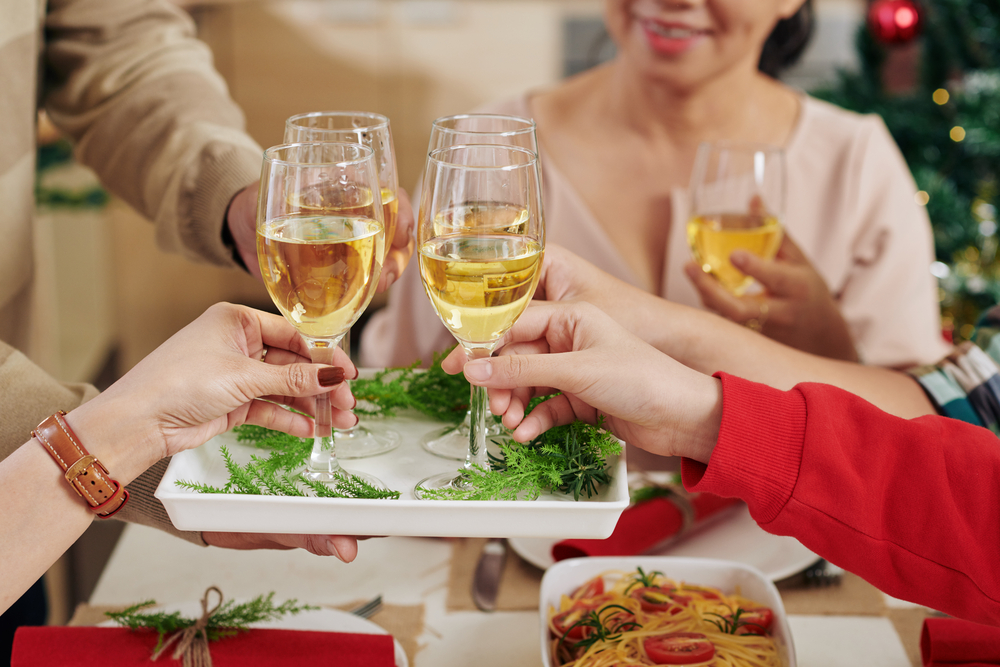- Home
- Blog
- Healthy Eating for Wellness
- How to not drink too much
How to not drink too much
Written by Catherine Saxelby
on Wednesday, 08 December 2021.
Tagged: alcohol, guides, health, healthy eating, healthy lifestyle, nutrition

After two challenging years of lockdowns, it seems only fair that we should fully embrace this festive season. But with more and more studies pointing to the dangers of drinking alcohol (as well as many people drinking way too much during those extended lockdowns), this post is a timely reminder!
At 29 kilojoules per gram (more than twice that of carbs or proteins), alcohol packs a serious energy punch.
What’s more, it loosens your inhibitions so you tend to eat more of the wrong sorts of foods – arancini balls, fried cheese balls, calamari fritters and fried chicken wings. Anything deep-fried, really.
The good news is, there is a way to strike a balance between enjoying yourself socially over the next month, and keeping your weight under control. All you need to know is a few diet tricks of the trade.
In the lead-up to Christmas, cut back on your drinking and it will spell big benefits afterwards. Read on to find out more.
10 consequences of excess alcohol consumption
Here are 10 negative consequences of drinking too much alcohol (these may help to motivate you):
- Hangovers
- Diuretic action and dehydration
- Allergic reactions
- Interference with medications
- Impairment of driving
- Depletion of B vitamins
- Reduced fertility
- Liver disease
- Brain shrinkage, loss of memory
- Cardiovascular problems
What to do
- On those occasions when you’re expected to always have a glass in your hand, dilute wine and spirits with soda or ice cubes, or ask for light beer.
- Avoid party punches and fancy cocktails – they’re deceptively alcoholic.
- If you’re driving, count your drinks. DO NOT DRIVE if you’ve had too many or you’re not sure. Call a cab, or ask someone else to drive you home.
- Try non-alcoholic and low-alcohol (NoLo) beers, such as Mornington Peninsula or Coopers Birell, or apple or pear cider, such as Bilpin or The Hills. These are lower in kilojoules and alcohol.
- Alternate with mineral water between regular alcoholic drinks.
- Eat something before you drink.

What’s a standard drink?
Standard bar glasses of drinks provide practically the same quantity of alcohol, despite differences in their alcohol content by volume. A small nip of rum contains 10 g alcohol (a standard drink), as does a glass of wine, champagne or port.
The following standard drinks all provide approximately 10 g alcohol.
| Beer – regular | 250 mL (2/3 can or 1 middie) |
| Beer – low alcohol | 375 mL can or bottle |
| Mixed spirit + soft drink | 300 mL glass |
| Wine, champagne | 100 mL (1 small wine glass) |
| Sherry, port | 60 mL (1 sherry glass) |
| Spirits (gin, vodka, whiskey, rum, bourbon) | 30 mL (1 nip) |
| Liqueurs (Tai Maria, Cointreau, Limoncello) | 30 mL (1 nip) |
Remember, a standard glass of wine measures only 100 mL, not 250 mL like those fashionably big balloon glasses.
Non-alcohol drinks
Don’t forget non-alcoholic options:
- Tomato juice (refreshing in hot weather)
- Grapefruit juice with mineral water
- Lime, soda and bitters
- Ginger beer or similar brewed soft drinks
- Non-alcoholic wine
- Zero-alcohol beers such as Peroni Liberi or Heineken
- Diet soft drinks
- Iced teas, iced coffees
- Clayton’s and soda
- Any cocktail minus the alcohol, e.g. watermelon fizzer without the vodka
The bottom line
Cut down, not cut out! This is my philosophy on most things food and drink. But it’s hard, I know.
You can still enjoy a drink but, to reduce your lifetime risk of alcohol-induced disease, aim to consume no more than two standard drinks on any day. Each standard drink contains 10 g pure alcohol.
This means that, over the next month, commit to a light intake or fasting day each week, such as a light meal, soup or salad. This is an easy and effective way to keep your overall intake down after a massive night of over-drinking.
Foodwatch
The Good Stuff
The Boring Stuff
© 2025 Foodwatch Australia. All rights reserved
Website by Joomstore eCommerce





